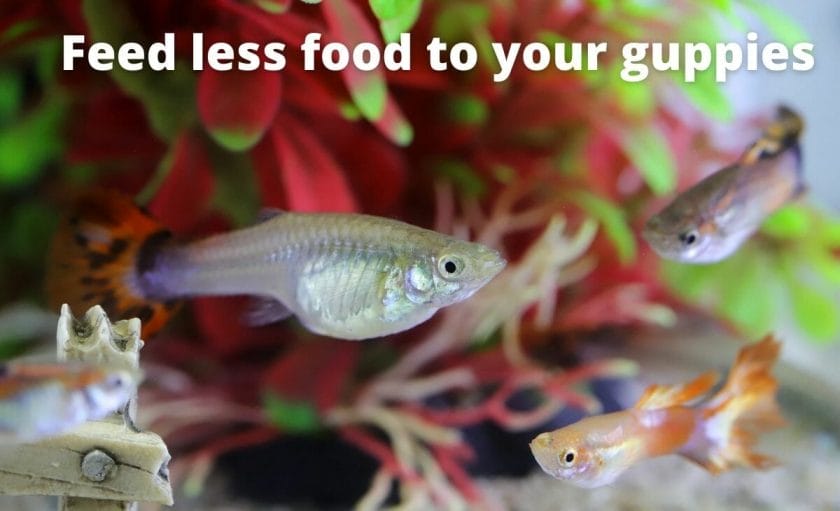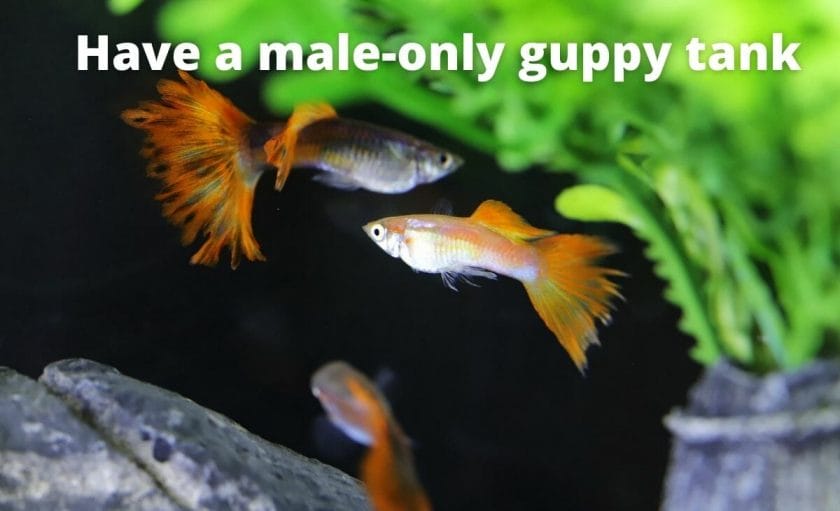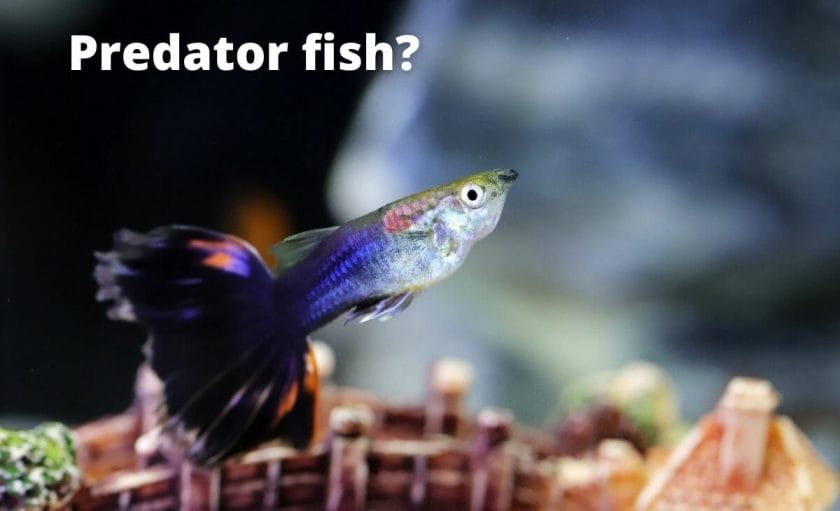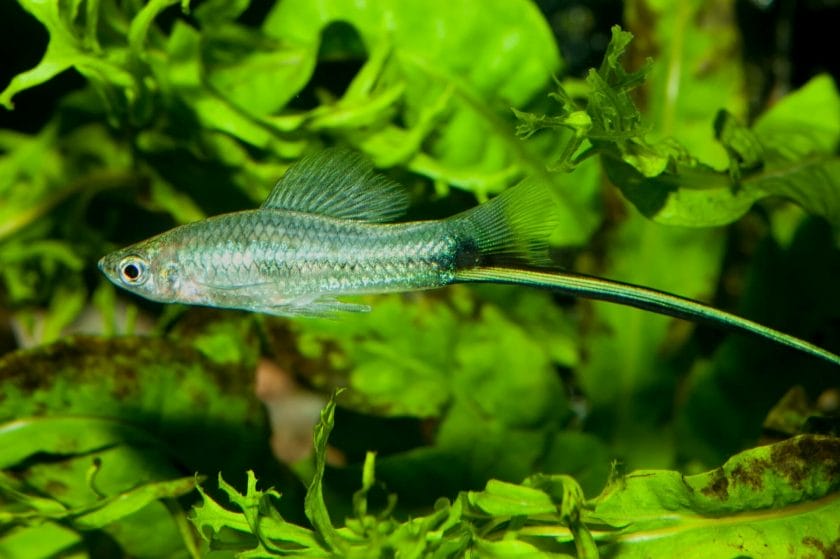Are you overwhelmed by the overpopulation of guppies in your tank? And you just want to know how to stop guppies from having babies!
I’m here to help!
In this article, I’m going to share a few different ways to control the guppy population in your tank.
Here’re the different ways to stop guppies from having babies
- Separate male and female guppies and keep them in separate tanks
- Have a male-only guppy tank
- Have a female-only guppy tank
- Keep fry-predator fish in your guppy fish tank
Now I’m going to dive deeper into each of the ways I’ve mentioned above.
I’ll also tell you how to get rid of the existing unwanted guppy fry you may already have!
So keep reading…

Table of Contents
1. Feed less food to your guppies

The first thing you should do if you don’t want a lot of guppy fry in your fish tank is – you should start feeding less food to your guppies.
Female guppies release the number of fry according to the availability of food. (source)
So when you start feeding less food to your guppies the female will start to release fever guppy fry in your guppy fish tank.
Now, this method doesn’t guarantee that you will not have any guppy fry in your fish tank. But at least you will have fewer guppy fry.
How and how much to cut back on fish food for your guppies?
There are two ways to go about it-
- Let’s say you are feeding two times per day to your guppies. In this case, you can cut back on the amount of food you are feeding to your guppies.
- Another way to cut back on food is – instead of feeding two times per day to your guppies start feeding them only once a day.
Now, you don’t need to feed less food to your guppies forever!
Later in the article, I am going to share with you several ways to actually stop guppies from breeding.
So until you implement any of those ways you should cut back on fish food for your guppies.
Now I am going to show you different ways to actually stop guppies from having babies!
2. Separate male and female guppies and keep them in separate tanks

If you have not purchased any guppies for your guppy fish tank. And if you don’t want any guppy fry wandering in your guppy fish tank then arguably the most effective way to stop guppy breeding in your fish tank is to keep male and female guppies in separate tanks.
You can implement this method even if you already have a guppy fish tank.
You can just set up a separate tank for either male or female guppies.
How to identify male and female guppies?
| Male guppies | Female guppies |
|---|---|
| Male guppies have shorter bodies than female guppies | Female guppies have rounder and bigger body |
| Male guppies are more colorful than female guppies | Female guppies are not as colorful as male guppies |
| Males don’t have a gravid spot | Female guppies have a gravid spot (a dark spot) under their body at the end of the stomach |
| Male guppies have longer dorsal fins than female guppies | Female guppies have shorter dorsal fins than female guppies |
| Male guppies have a wide, long, and colorful tail fin. | Female guppies have shorter tail fins and the tail fin is not as colorful and vivid as male guppies |
| Male guppies have a longer pointed anal fin than female guppies | Female guppies have a shorter anal fin than male guppies |
Below is the video that shows you exactly how to identify male and female guppies in your fish tank.
Once you know how to identify male and female guppies then you will just need to set up another guppy tank. And put either male or female guppies in the fish tank.
Don’t forget to cycle your new fish tank before putting the fish in the tank.
If you already have a fish tank then you can instantly cycle your new fish tank using your old fish tank/established fish tank. Here is the article that shows you exactly how to do it.
Keeping male and female guppies in a separate tank doesn’t guarantee that you will not see any guppy fry!
Even when you keep male and female guppies in a separate tank there is still a possibility that you will end up with guppy fry in your female guppy fish tank.
Now you may be asking, why is that?
Well, there are a couple of reasons you will end up with guppy fry in your female guppy tank.
The female is already pregnant
When you keep male and female guppies in separate tanks, there is a possibility that the female guppies are already pregnant with guppy fry. So you will end up with guppy fry in the female guppy tank.
Female guppies can literally store sperm in their bodies
You read it right! Once inseminated female guppies can store sperm in their ovaries and gonoducts. (source)
Because of this function, female guppies can use the sperm stored in their bodies to get pregnant and give birth to guppy fry over and over again.
They don’t need to mate with any male to produce guppy fry each time!
How to get rid of guppy fry from your female guppy fish tank?
If you noticed guppy fry in your female guppy fish tank then you should cut back on feeding them.
This will ensure that they will not produce as many guppy fry the next time they give birth.
Secondly, you need to know that guppies are not good parents!
They show cannibalistic behavior. So they are going to eat their own fry and so not every fry is going to survive.
Thirdly, you could keep other guppy fry predator fish in your female guppy fish tank. So the predators will also eat the fry.
3. Have a male-only guppy tank

If you have not already purchased guppies for your fish tank, the one thing you can do to make sure that you will never have guppy fry in your fish tank is you should keep only male guppies in your guppy fish tank.
This is the most effective way which guarantees that you will never have guppy fry in your fish tank ever.
One of the most important benefits of keeping a male-only guppy tank is that males are more colorful and vibrant than females. So you will have only the colorful and vibrant guppies in your tank.
Now, if you want to keep only male guppies in your tank, you’re probably wondering how do I actually identify them.
How to identify male guppies?
| Male guppies | Female guppies |
|---|---|
| Male guppies have shorter bodies than female guppies | Female guppies have rounder and bigger body |
| Male guppies are more colorful than female guppies | Female guppies are not as colorful as male guppies |
| Males don’t have a gravid spot | Female guppies have a gravid spot (a dark spot) under their body at the end of the stomach |
| Male guppies have longer dorsal fins than female guppies | Female guppies have shorter dorsal fins than female guppies |
| Male guppies have a wide, long, and colorful tail fin. | Female guppies have shorter tail fins and the tail fin is not as colorful and vivid as male guppies |
| Male guppies have a longer pointed anal fin than female guppies | Female guppies have a shorter anal fin than male guppies |
Below is the video that shows you how to identify male and female guppies in your fish tank.
Aggression- the problem you will see in a male-only guppy tank
When you keep only male guppies in a fish tank you will see a lot of aggression among them.
Now, this is a very natural behavior of guppies. However, when you keep only male guppies (and no females) you’ll see a lot of aggression. This stresses the fish.
If a fish is continuously stressed then this can lead to diseases in the fish. And the disease can spread throughout the tank.
How to control aggression among the males in a guppy fish tank?
There are a few ways to cope with the aggression and reduce the aggression among males in a male-only guppy tank.
- First of all, you should choose a larger tank to keep male guppies in a fish tank. A larger tank will give more space to all the male guppies in your fish tank which can help to reduce aggression.
- You should keep at least 6 male guppies in your guppy fish tank so the aggression will spread among them. And only one fish with not be targeted over and over again.
- While choosing fish for your male guppy tank, it is very important that you should choose fish of similar size.
- You should also create a lot of hiding places in your male-only guppy tank so if a fish is stressed then it can hide and relax and recover. Adding a lot of live aquarium plants is a great way to create hiding places in a guppy fish tank.
- You should also keep all the males in your guppy fish tank well-fed so they will not have to compete for food and get aggressive during feeding time.
These ways will surely help you to reduce aggression among the males in your guppy fish tank.
Actually, I have written a detailed article covering all these ways in more detail. You can check out the article here
3. Have a female-only guppy tank

You can keep only females in your guppy fish tank if you don’t want any fry in your fish tank.
How to identify female guppies?
| Male guppies | Female guppies |
|---|---|
| Male guppies have shorter bodies than female guppies | Female guppies have rounder and bigger body |
| Male guppies are more colorful than female guppies | Female guppies are not as colorful as male guppies |
| Males don’t have a gravid spot | Female guppies have a gravid spot (a dark spot) under their body at the end of the stomach |
| Male guppies have longer dorsal fins than female guppies | Female guppies have shorter dorsal fins than female guppies |
| Male guppies have a wide, long, and colorful tail fin. | Female guppies have shorter tail fins and the tail fin is not as colorful and vivid as male guppies |
| Male guppies have a longer pointed anal fin than female guppies | Female guppies have a shorter anal fin than male guppies |
Below is the video that shows you how to identify male and female guppies.
Now, this method doesn’t guarantee that you will not have any guppy fry in your fish tank because there is a possibility that the female guppies are already pregnant with the fry.
Also, as I mentioned earlier, female guppies can literally store sperm in their bodies. And they can use this sperm over and over again to get pregnant and produce offspring.
So don’t be surprised if you see guppy fry in your female-only guppy tank.
How to get rid of guppy fry in your female-only guppy fish tank?
Now that you know there’s a probability that you can end up with guppy fry even if you keep only female guppies in your tank. You may be wondering, how can I get rid of those fry if I found myself in that situation?
Don’t worry. There is a way!
Feed less food to the female guppies
First of all, in your female-only guppy fish tank if you see any guppy fry then you should start feeding less food to the female guppies. This will ensure that the females will reduce the number of guppy fry the next time.
Guppies are not good parents
Guppies are not good parents. They eat their own babies.
So out of all the guppy fry in your female guppy tank, some of the fry will get eaten up by female guppies so not every fry is going to survive.
Keep fry predator fish in the female-only guppy tank
If you want most of the guppy fry to be eaten up then you could keep other fry predator fish in your female-only guppy fish tank. They will eat the remaining guppy fry.
Now I am going to talk about the predator fish you can keep in your guppy tank with all the details.
4. Keep fry-predator fish in your guppy fish tank

When you separate male and female guppies and keep them in separate tanks. O if you got only female guppies in your fish tank then, as I mentioned earlier, there is a possibility that you can still end up with guppy fry in your female guppy fish tank.
This is because there is a possibility that the female guppies are already pregnant with the guppy fry. So when you keep them in a separate tank they will produce offspring after some time.
Besides, female guppies can store sperms in their bodies. And they can use this sperm to get pregnant over and over again and produce offspring.
So, in this case, how can get rid of guppy fry in your female guppy tank?
Feed less food to the female guppies
First of all, you need to know that not all guppy fry are going to survive in your female guppy fish tank because the females can eat and will eat some guppy fry.
Generally, female guppies will eat more guppy fry if you feed them less food.
Besides, when you are keeping only females in a guppy fish tank, in the beginning, you should feed them less food because female guppies produce offspring according to the availability of food.
So if you feed them less food then the female guppies will produce fewer guppy fry.
Keep guppy fry predator fish in your female guppy tank
Female guppies will not eat all the guppy fry in your guppy fish tank.
So, in this case, to get rid of all the guppy fry or at least to get rid of as many guppy fry as possible, you can keep other fry predator fish in your guppy fish tank.
As the name suggests, the fry predator fish will eat guppy fry which will help to control the guppy fry population in your guppy fish tank.
Tip: If you noticed guppy fry in your guppy fish tank then you should remove as many ornaments and live plants in your guppy fish tank. So the guppy fry will not have hiding places to hide. This way they can be easily seen by the adult guppies and other fry predator fish and get eaten.
Choose the right fish tank size according to the fry predator fish you are going to keep in your guppy fish tank
When you are keeping fry predator fish in your guppy fish tank you will also need to consider your guppy fish tank size.
For example, if you decide to keep a large predator fish, for example, angelfish in your guppy fish tank then you will also need a bigger fish tank to keep it with your guppies.
On the other hand, if you decide to keep a smaller fry predator fish like a Betta fish in your guppy fish tank when you really don’t need a very large tank. Because Betta fish doesn’t grow very large.
Which fry Predator fish you can keep in your guppy fish tank?
There are quite a few options when it comes to keeping fry Predator fish in your guppy fish tank.
1. Betta fish

| PARAMETERS | VALUES |
|---|---|
| FISH | Betta Fish |
| SCIENTIFIC NAME | Betta splendens |
| CARE LEVEL | Easy |
| MAXIMUM SIZE | 2.25-3 inches |
| AVERAGE LIFESPAN | 3-5 years |
| DIET | Omnivores |
| WATER TEMPERATURE | 77° and 86° F |
| WATER pH | 6 - 7.5 |
| WATER HARDNESS | 5° to 20° dH |
| MINIMUM TANK CAPACITY | 2 gallons |
| BREEDING | Egg layer |
Betta fish are commonly put in our guppy fish tank to control the guppy fry population because they are very good at eating guppy fry.
Now, Betta fish can be aggressive towards guppies if you keep them in a very small tank.
So generally, if you want to keep Betta fish in your guppy fish tank then you should keep them in a relatively bigger tank.
For example, if you are keeping let’s say 6 guppies in a 10-gallon tank then if you want to keep a Betta fish with your guppies then you will need to keep them in a 15-gallon tank.
A larger tank will give a lot of space for Betta fish so it will not turn territorial and aggressive towards the guppies.
2. Angelfish

| PARAMETERS | VALUES |
|---|---|
| FISH | Angelfish |
| SCIENTIFIC NAME | Pterophyllum scalare |
| CARE LEVEL | Easy |
| MAXIMUM SIZE | Up to 6 inches |
| AVERAGE LIFESPAN | 8 - 10 years |
| DIET | Omnivore |
| WATER TEMPERATURE | 78 to 84 °F |
| WATER pH | 6 - 7.5 |
| WATER HARDNESS | 5° to 13° dH |
| MINIMUM TANK CAPACITY | 20 gallon minimum |
| BREEDING | Egg layer |
Angelfish is one of the most popular tropical fish in the aquarium hobby and for a good reason.
Angelfish have quite unique look so they are very interesting to look at.
Angelfish can grow pretty large so they will also consume a lot of guppy fry in your guppy fish tank helping you control the population of guppies in your tank.
Besides, generally, angelfish are very peaceful fish and they will not get aggressive towards your guppies.
Angelfish only turn aggressive if they are threatened. As guppies are very peaceful and small fish, angelfish aggression will not be a problem in your guppy fish tank.
Though Angelfish can get quite large, they have very small mouths. So they will not eat the adult guppies in your fish tank. And they can only eat the guppy fry in your fish tank which you want to control the population.
If you’re going to keep angelfish with your guppies then make sure to keep them in a larger tank.
3. Gourami fish

| PARAMETERS | VALUES |
|---|---|
| FISH | Pearl Gourami |
| SCIENTIFIC NAME | Trichopodus leerii |
| CARE LEVEL | Medium |
| MAXIMUM SIZE | 4-5 inches |
| AVERAGE LIFESPAN | Up to 5 Years |
| DIET | Omnivorous |
| WATER TEMPERATURE | 77°F - 82°F |
| WATER pH | 6 - 8 |
| WATER HARDNESS | 5° to 15° dH |
| MINIMUM TANK CAPACITY | 30 Gallons |
| BREEDING | Bubble nest builder |
Another beautiful and colorful fish you can keep in your guppy fish tank to control the guppy fry population is gourami fish.
Gourami is a very good choice to control the population in your fish tank because they are quite large fish. And so they can consume a lot of guppy fry in your fish tank.
Now gouramis can get very aggressive with each other.
However, they usually don’t get aggressive towards other smaller species of fish. So you can keep gourami fish in your guppy fish tank.
Besides, gourami fish are very slow-moving fish. So even if they get aggressive towards your fast-moving guppies, guppies can easily survive in the tank.
4. Swordtail fish

| PARAMETERS | VALUES |
|---|---|
| FISH | Swordtail |
| SCIENTIFIC NAME | Xiphophorus helleri |
| CARE LEVEL | Easy |
| MAXIMUM SIZE | 5 inches |
| AVERAGE LIFESPAN | 3 - 5 years |
| DIET | Omnivores |
| WATER TEMPERATURE | 72°F - 82° F |
| WATER pH | 7 - 8 |
| WATER HARDNESS | 9° to 15° dH |
| MINIMUM TANK CAPACITY | 10 gallon |
| BREEDING | Livebearer |
If you want to keep a peaceful small species of fish in your guppies fish tank then Swordtail fish can be a great choice.
Swordtail fish are very interesting to look at because they have quite unique bodies. They have a sword-like structure as a fin hence the names for swordtail.
Swordtail fish are very easy to take care of so they’re a very good choice for beginners.
Though swordtail fish is a peaceful fish, they’ll eat the guppy fry in your guppies fish tank, helping you to control the population of guppy fry in the tank.
How do I get rid of unwanted baby guppies?
If you ended up with guppy fry in your tank then there are a few things you can get rid of the guppy fry.
Let’s start with the simplest one.
1. Give the guppy fry to your friends
If you have aquarist friends then you can give the guppy fry away to your aquarist friends.
2. Feed the fry to other fish
Guppy fry is a very natural and nutritious food for most fish.
So, if you have any other fish tank then you can feed the guppy fry to those fish.
3. Grow the guppy fry and then sell it for profit
If nobody is interested in getting your guppy fry and you don’t have any fish to feed them the guppy fry. Then another option for you is to actually grow the guppy fry and then sell it for profit.
If you haven’t bred any fish then breeding guppies is very easy to start with.
And once the guppy fry are grown up then you can sell it either online on craigslist or you can use Aquabid.com to sell them.
You can also sell the guppies to your local fish store.
Conclusion
There are several ways to stop guppies from having babies.
You can have a male-only or a female-only guppy fish tank.
If you already have male and female guppies then you should separate them to stop them from breeding.
Even when you see guppy fry in your fish tank, not all the fry are going to survive because guppies eat their own babies.
In addition, you can also keep other fry predator fish in your guppy fish tank to get rid of all the guppy fry from your fish tank.
I hope you found all the details I have mentioned throughout the article for each way of stopping guppies from breeding helpful.
If you do, please share it.
Happy fishkeeping!